This is a pretty good hook for a video series:
Long story short, I’m living with a family displaced from the war, former drug addict/alcoholic father, extremely poor, etc… but they also have the best functioning family I’ve ever come across. They are beautiful. There’s a lot to be learned here, and it’s been quite a radical and challenging adventure so far living outside of my language and normalities.
Fish Out of Water starts on YouTube today.
From Coudal Partners Fresh Signals this morning:
Thanks Pearle Vision for making me cry in my office this morning, Ben’s Glasses.
That was enough to get cynical old me to tap, while sitting waiting for my lunch to be served, this afternoon. And I did cry, right there in the restaurant.
It’s a brilliant ad.
I just watched it again, and tears rose up again.
Twice in the past month, once in a meeting and once in a telephone conference call, someone has used the phrase “let’s take this offline.”
By which they’ve meant “let’s not talk about this now, let’s talk about this later.”
But the phrase makes no sense to me: if we’re discussing something face-to-face (or telephone receiver to telephone receiver), we’re already offline, aren’t we?
Maybe I’m interpreting this too literally, but it gets even more confusing when you realize that when people say “let’s take this offline,” they often mean “let’s exchange some email about this after the meeting.”
In other words what they really mean is “let’s take this online.”
Am I missing something?
Since I decamped from social media six months ago, I haven’t really looked back. I’ve sent a couple of Twitter direct messages to people that I only know how to reach that way, but otherwise I’ve been absent from Twitter and Facebook and haven’t missed them at all. It all seems like a strange addiction now. So much pith, so much scrolling, so little satisfaction.
But then I started sketching, and I started to post some of my sketches on Instagram. And now I do it as a regular thing.
I like that, as a side effect of this, I’ve been able to chat, in real life, to a collection of people who follow me on Instagram about what I’m sketching, and how I’m sketching; it’s good feedback and great fun both. I like that other people have started sketching and posting their sketches, following my lead. I like seeing what they come up with.
And I enjoy, I must admit, the rush from the micro-dose of dopamine that comes when someone likes one of my sketches.
So I’ll keep posting, at least for a while; it’s a good summer to micro-dose on dopamine. But I’ll also remember to post sketches here too, because while Instagram is an ephemeral public canvas, this space is mine, and I don’t want to lose these moments to my personal historic record; future me should have a way to remember.
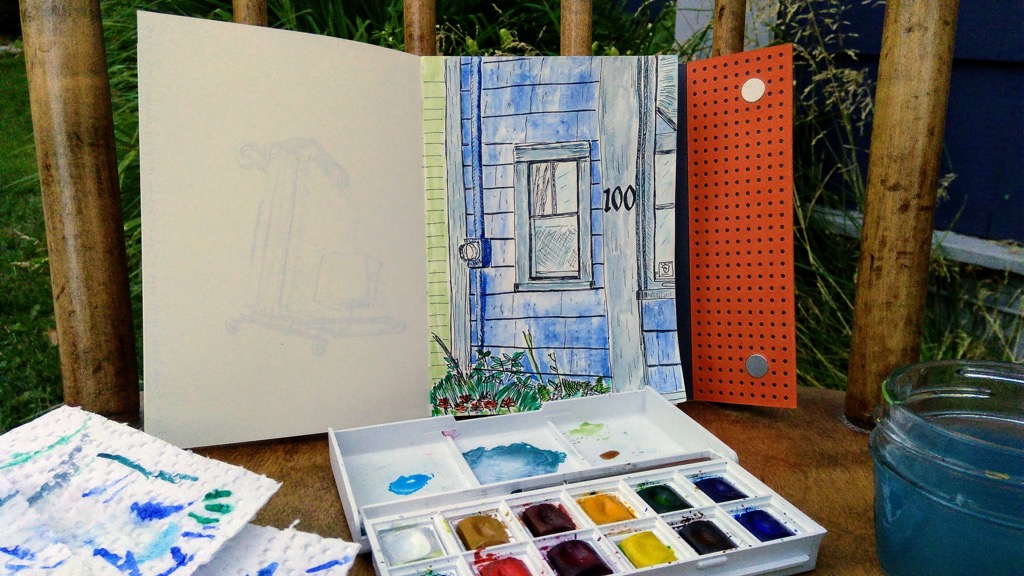
Magazine B has a list of places you can buy it. You could do worse that planning a world tour that saw you stopping at each.
I was on a conference call with a vendor today as was required to use a video-conference platform called Zoom to participate.
In the preferences for the app was a checkbox titled “Touch up my appearance”:
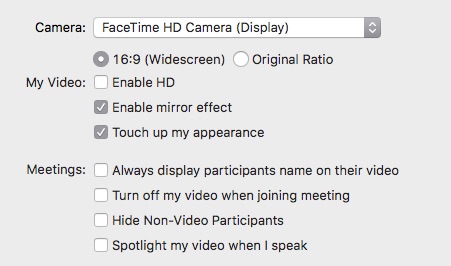
Here’s a before-and-after of me in regular everyday appearance and me “touched up” by the app:


I’ve never felt so haggard.
It all started a couple of weeks ago: my friend the restaurateur needed help getting the email on his iPhone set up again after unlocking it as part of switching wireless carriers.
In the discussion that ensued, he related the tale og how he was constantly going over his monthly wireless data limit with Rogers, his former wireless provider; he’d contacted Eastlink to see whether they would do better, and they offered him a deal that was too attractive to refuse: $40 per month per line with 3GB of data and unlimited Canada-wide calling and texting.
My ears were extra-perked to this kind of talk, for that very morning I’d paid my Virgin Mobile bill and had to fork out a $25 data overage charge for Catherine’s line (she’d been listening to Spotify while in the hospital), and I was, in any case, already paying $55 per line per month for only 1GB of wireless data.

I contacted the salesperson at Eastlink my friend had dealt with, and she confirmed that, as long as I was an incorporated business, I was eligible for the same deal.
After confirming that Catherine’s phone–an older Moto G–and mine–a Nextbit Robin–would operate on Eastlink’s wireless 1,700 MHz network (they have a handy tool for this), I called Virgin Mobile and gave them the opportunity to counter.
They couldn’t: they would increase my data, and lower my bill from $55 per line per month to $51, but they’d remove Canada-wide calling to do so.
So I told Eastlink to go ahead. The salesperson emailed me a service agreement, I signed it and emailed it back, and two days later a Purolator package arrived with two SIM cards.
I spent 30 minutes on the phone with Eastlink’s support department to port our Virgin numbers–more time that I would have liked, but at least I only had to do it once–and we’re now happy customers of Eastlink.
The final result: our monthly wireless bill (assuming no data overages) will go from $111.40 down to $81.76. But Eastlink also gave us a $400 “port-in credit” per line, meaning that we won’t actually have any wireless bill for the next 9 months or so.
Once I was up and running with my new Eastlink SIM last night, I did a speed test, and here was the result:

My Eastlink-enabled wireless phone now has 60% of the throughput that my Eastlink-enabled home Internet does “down,” and 200% of the throughput “up.”
Oh, and this.
Swapping art is the greatest.
And my Map of Charlottetown has enabled it, twice.
First, with Jeff Macklin from Jackson Creek Press in Peterborough, who swapped a map of there with the map of here, but slipped some extra things in the envelope, pictured below.
And, second, with Monica Lacey, of Outmost Fitzroy Street, who swapped me an underwater print for the selfsame map (second from the left) below.
Oh, and the chicken on the right: that’s a Stephen B. MacInnis. Paid cash for that, but I love it nonetheless.
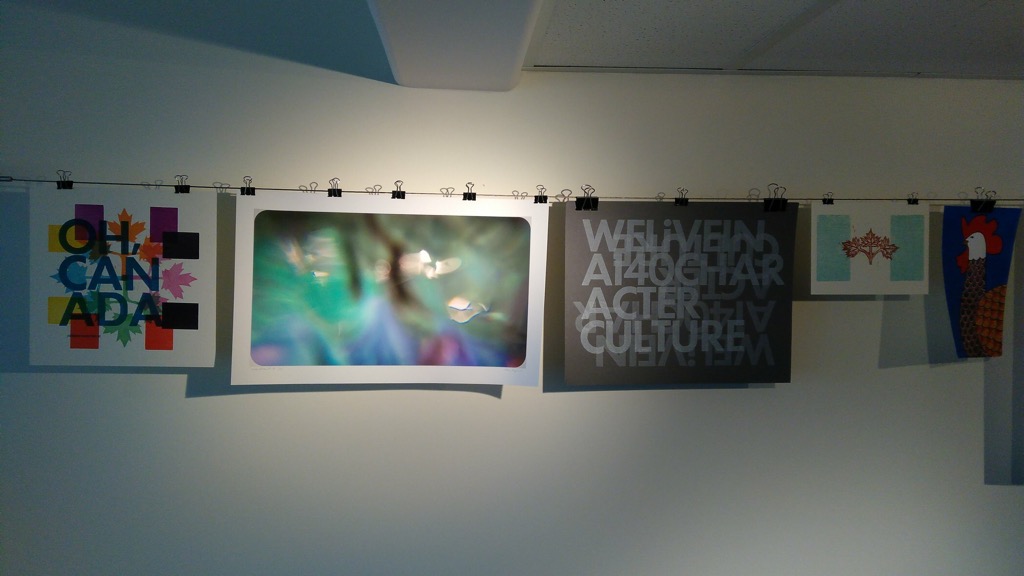
Something to swap that can slip in an envelope? I’ve got plenty to offer in return. Drop a line.
There is this thing that is variously called “two-factor authentication” (TFA or 2FA) or “multi-factor authentication” (MFA) or just “one-time passwords.”
If you don’t know about it, it would be a good idea to set aside some time to learn: no matter whether you’re an information systems professional or a regular everyday civilian, while it will (slightly) complicate your digital life, it will also make your digital life more secure.
If you’ve ever logged into a service and have been required to enter your mobile number and then wait for a code to be sent to you by text message then you’ve already used TFA, and you already know most of the important bits: it’s simply a way of websites to ask you to login using more than one identifying piece of information (hence the “two” or “multi”). Like your username, your password and a code that gets texted to you.
There are generally two ways that the “second factor”–the additional code you must enter to continue–is communicated to you: by text message, or by a special “one time password” app that generates expiring 6-digit codes.
Google Authenticator for mobile phones is likely the most common example of the latter, but it’s got some serious limitations, most of all that you need to have your phone with you (and out of your pocket) every time you want to login, but also that if you happen to lose your phone (or need to reset your phone, or get a new phone), you can be left without the ability to login. Anywhere.
The alternative that I’ve settled on is to use the built-in one-time password support for 1Password.
If you’re not using 1Password, please stop reading right here and go and purchase and install it on all your devices.
Really. I’ll wait right here while you do this.
Are you done? Great. (If you resisted, please stop and, really, go and get 1Password: it will not only make your digital life far, far easier to manage and far, far more secure, but it will also save you the task of keeping track of which password is which on chits of paper).
There’s a lot more to 1Password than one-time passwords, and there’s a learning curve that you need to ride up before you’re comfortable, so you may want to bookmark this post and come back once you’re riding higher.
But to give you a taste, here’s what logging into a website with TFA enabled looks like, in this case my login to Amazon Web Services.
I go to the login page and, as you are used to from innumerable other websites, I enter my username and password (my password is a long and complex one, and one I only use for Amazon Web Service: this is easy to manage with 1Password):
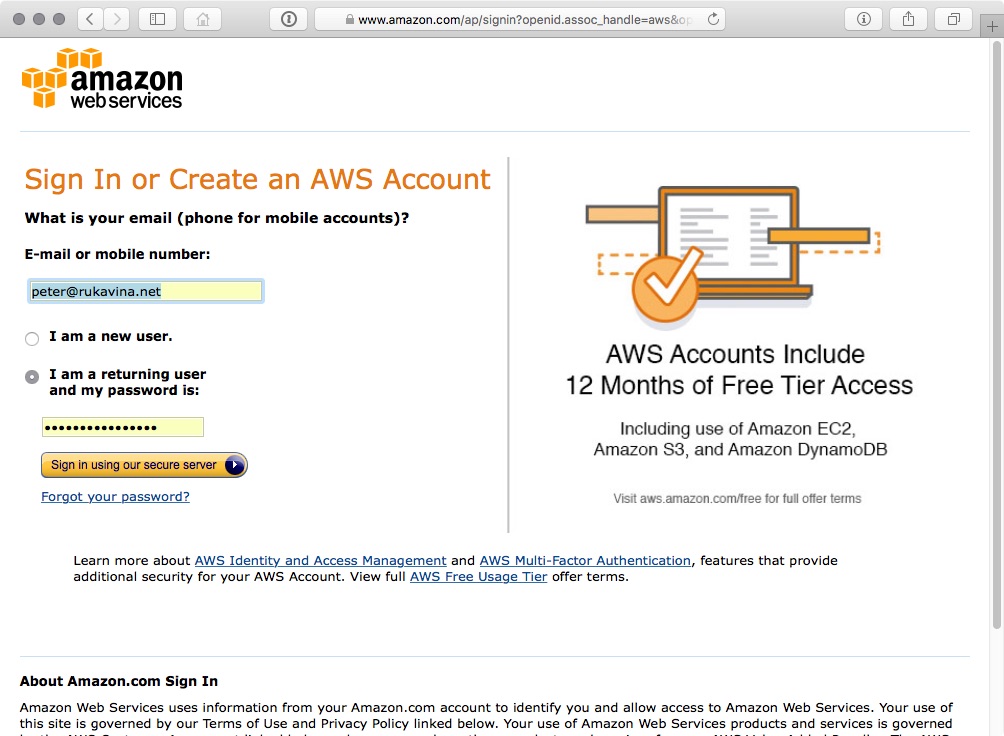
At this point, rather than logging me in, Amazon Web Services prompts me for a one-time password (they call it an “authentication code”):
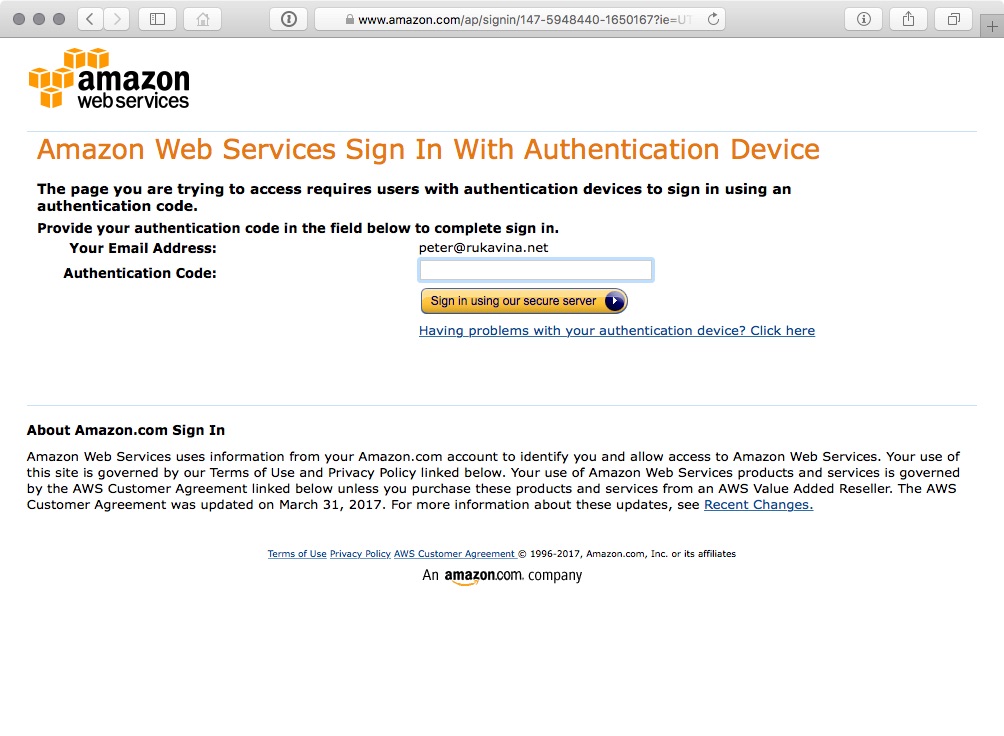
I pop over to 1Password to get this:
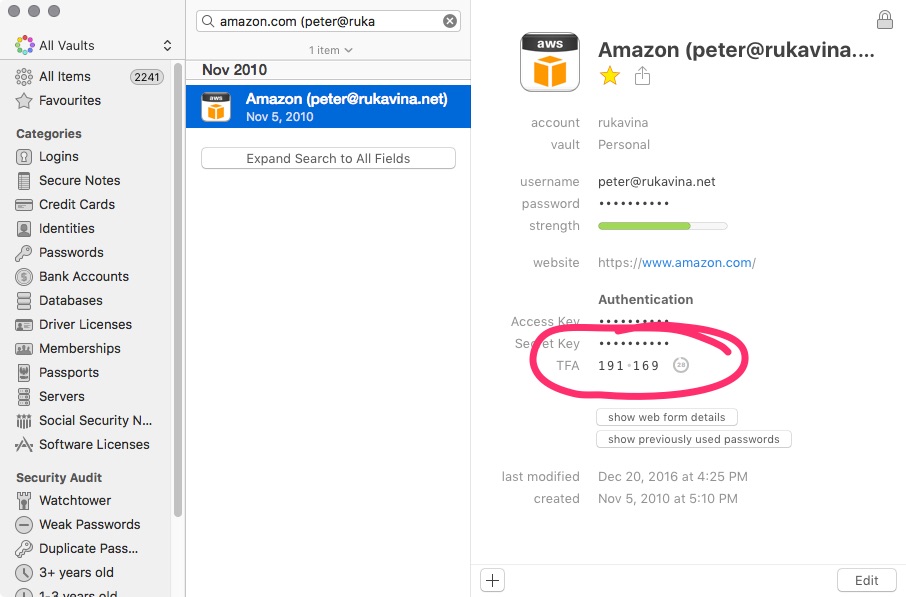
I copy and paste that one-time password–191169–into the Amazon Web Services “authentication code” field, and, presto, I’m logged in (the one-time passwords expire every 60 seconds, so by the time you read this post that 191169 has long-expired).
The great thing about using 1Password to keep track of both my accounts and their passwords and to generate one-time passwords is that everything automatically gets synced between my laptop, my phone, and my tablet. Meaning that when I’m here in the office I use my laptop to login, but when I’m at home or out in the field I use my phone or tablet. And the loss of any of those, (or, indeed, all of those, as I can get the same information over the web, logging in using the 1Password Emergency Kit that I’ve printed off) doesn’t render me stranded.
Today an update was released for 1Password that makes doing all this even easier:
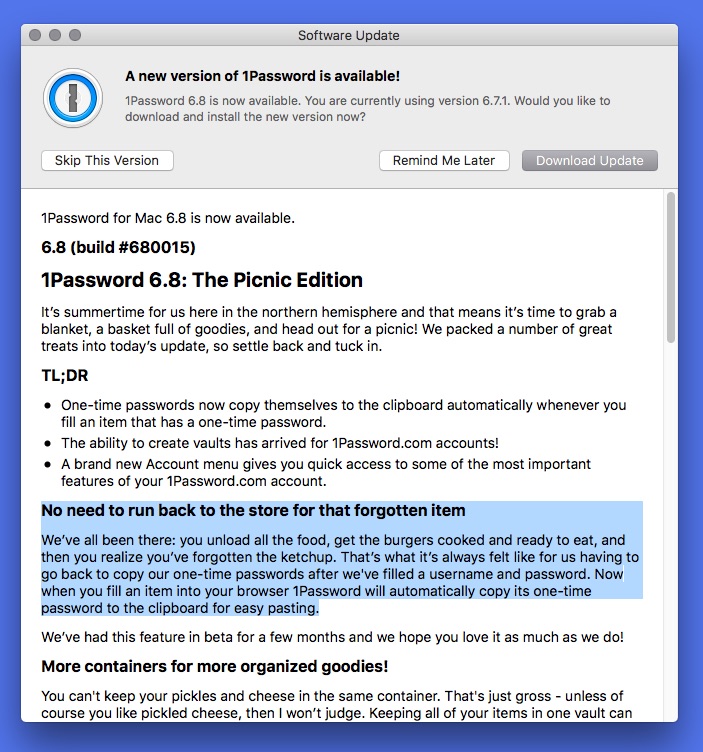
As it says there, “now when you fill an item into your browser 1Password will automatically copy its one-time password to the clipboard for easy pasting.”
Which is brilliant, and will be a huge remover of friction for me, as I enter one-time passwords from 1Password many, many, many times a day.
I’m happy to answer questions about any of this.
And I wasn’t being facetious about your need to use 1Password: go do it, now.
The Province House restoration dishes up an new serving of visually interesting sketch material every day. We are currently in the sunny period leading up to the installation of the exoskeleton (the prospect of which almost makes my brain explode with possibility). And so a trench has been dug almost all the way around, exposing the foundation (and taking away with it many of the minor stairways). And so the trench doesn’t fill with rainwater, a complex network of drainpipe extensions has been installed.
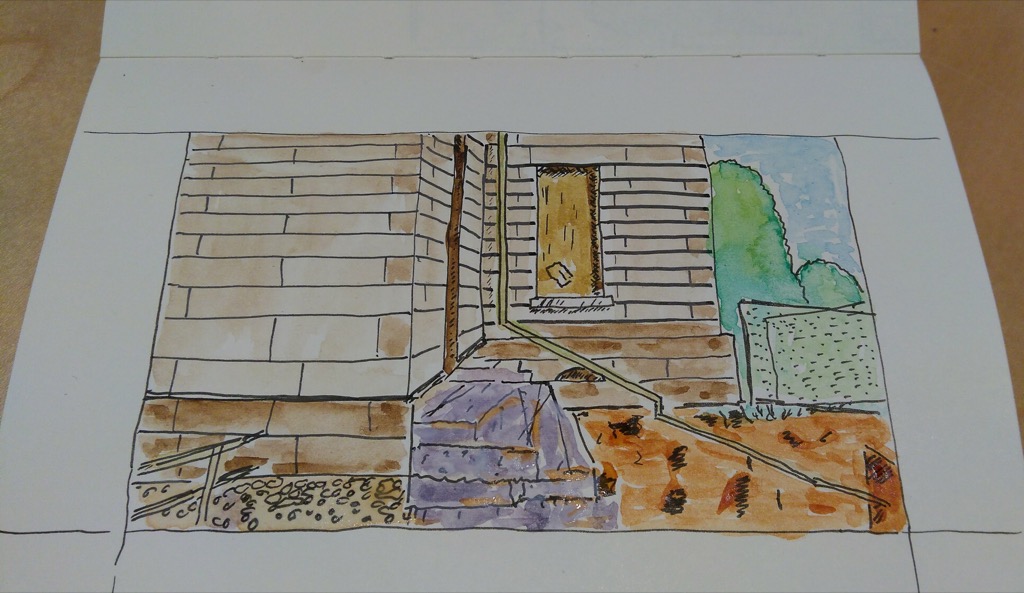
 I am
I am